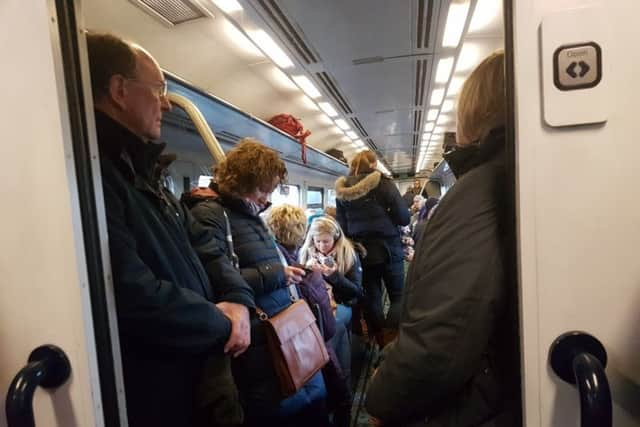Scotland's 10 most overcrowded trains revealed in new report
They include a 21-minute morning rush hour journey between Linlithgow and Haymarket in Edinburgh.
It was revealed in the latest list of the operator’s busiest trains, which showed some are running with one third more passengers than seats and designated standing space.
Advertisement
Hide AdAdvertisement
Hide AdThe worst was the 1634 (4:34pm) from Edinburgh to Perth, which was busiest over its 17-minute journey between Haymarket and Inverkeithing.
The two-carriage train has carried 234 passengers despite its official capacity being 172 seated and standing.
Other trains in the top ten included on the Neilston-Glasgow Central, North Berwick-Haymarket and Edinburgh-Glenrothes lines.


The train that was busiest for longest was the 9:28am from Dunblane to Edinburgh, between Linlithgow and Haymarket.
The statistics were based on a mix of snapshots and automated passenger counts, but exclude trains where the level of overcrowding is for under ten minutes.
The figures, compiled by the Scottish Government’s Transport Scotland agency, underline the acute need for extra carriages at rush hours.
They were compiled in May but the introduction of two new fleets of ScotRail trains to provide more capacity have both been delayed since then.
Transport Scotland said ScotRail was obliged “to provide passengers with a reasonable expectation of a seat within ten minutes of boarding a train, and to minimise any forecast overcrowding”.
Advertisement
Hide AdAdvertisement
Hide AdIt said this was a “much stricter rule” than south of the Border, where the limit is 20 minutes.
Scottish Liberal Democrat transport spokesman Mike Rumbles, who highlighted the figures today, said: “Commuters and tourists are shelling out more money than ever before to perch in corridors on overcrowded trains. Rail fares have consistently risen faster than wage increases.
“We will never tempt motorists out of their cars and on to public transport if being packed in like sardines is what they have to look forward to.
“Extra capacity is desperately needed but we know that the new trains which are supposed to provide this won’t now be delivered in full until April 2019. This is well behind the original schedule.
“Not only are the new trains not in place, existing trains are busier than ever after some leases were allowed to expire.
“People want to see evidence that their ticket costs are being invested in improving services and infrastructure, but promises have yet to be delivered.
“It is time Scotland has a transport system fit for the 21st century.”
Only a few of ScotRail’s 70 new electric trains are in service, which are scheduled for several lines in the top ten.
Advertisement
Hide AdAdvertisement
Hide AdIn addition, none of its 26 refurbished InterCity diesel trains for longer distances routes are yet carrying passengers. Transport Scotland’s report had stated the trains “will be introduced from May 2018”.
A ScotRail spokesperson said: “The work we are doing to introduce brand new and upgraded trains will significantly boost the number of seats available to our customers across the country.
“Customers across the network are already benefitting from the considerable investment in our trains and we are working round the clock to deliver even more.”
A Transport Scotland spokeswoman said: “We wholly appreciate the impact of overcrowding on rail services and, as such, actively publish the top ten busiest trains in an open and transparent fashion on an annual basis.
“Our £475 million investment in the new Hitachi trains, as well as £54m in a fleet of fully refurbished High Speed Trains, will transform travel across our key routes and inter-city rail travel between our seven cities.
“ We’ve extended the leases of more than 30 trains to support the on-going fleet introductions, providing more seats and improved facilities across many routes.
“By 2019 we will have increased capacity by 50 per cent over 2007 levels and passengers across the country will reap the benefits of this.”
Comparison of the figures with those for 2016 show the most overcrowded trains this year are less busy but the problem has shifted between services and lines.
Back then, the busiest train was the 1721 (5:21pm) Edinburgh-Glasgow Central, at 146 per cent capacity.
